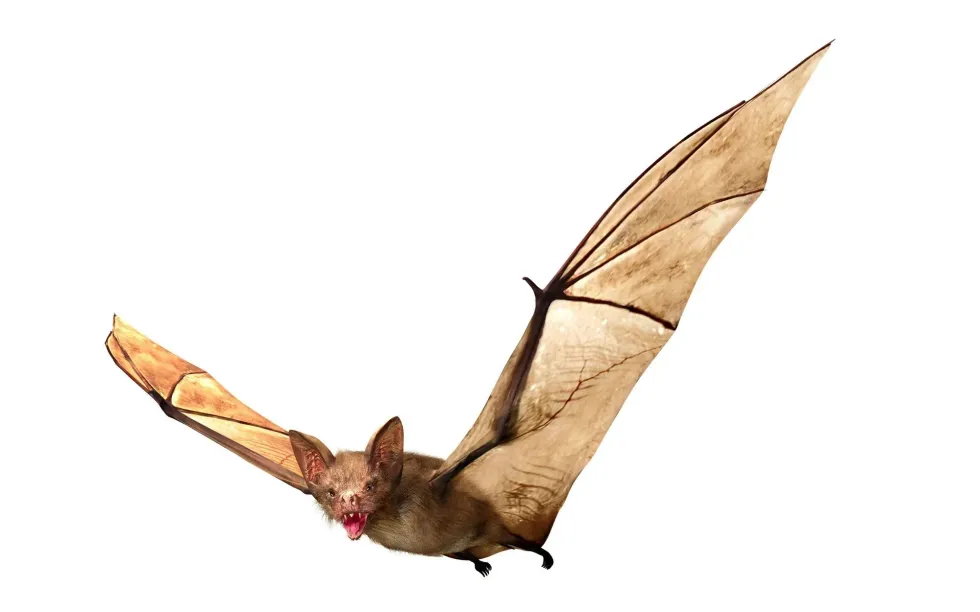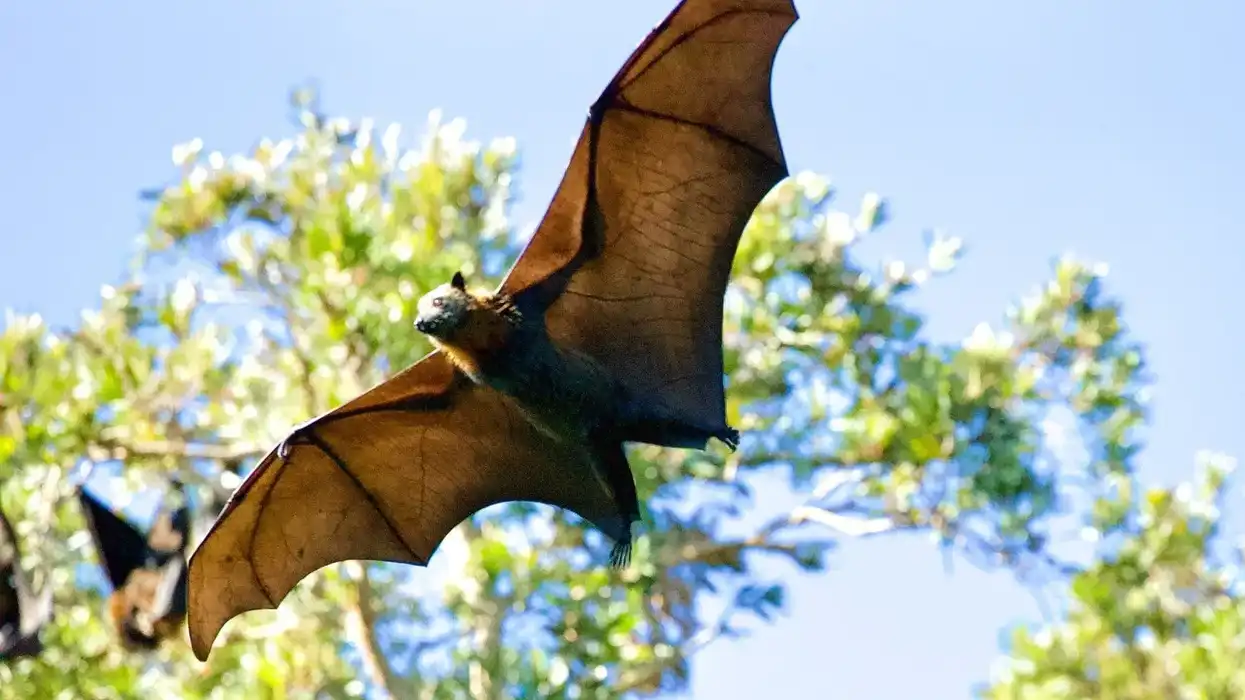Vampire bats are native to the warm, humid, and arid regions of the Americas, particularly Central and South America and Mexico. This group of mammals has three unique bat species, all sharing the unique feature of being sanguivorous.
In other words, vampire bat species feed exclusively on other animals' blood.
However, unlike the usual depiction of vampires sucking human blood in horror and fantasy movies, vampire bats would rarely be seen feeding on human blood. In fact, the vampire bats mostly prey on domestic fowl and livestock such as turkeys, chickens, Guinea fowls, and other poultry birds.
The three species of blood-feeding vampire bats are the common vampire bat, the hairy-legged vampire bat, and the white-winged vampire bat. While the common vampire bat is most abundant, the hairy-legged vampire bat and white-winged vampire bats are relatively lesser-known.
While all the three species are found in Central and South America, they differ in terms of physical appearance and the animals they feed on. For instance, the common vampire bat feeds cattle blood, and the other two species mainly feed birds' blood.
Coming to the white-winged vampire bat Diaemus youngi, the species is known for its exclusive blood-based diet. For the most part, they look like any other bat species.
The fur-covered body is a shade of dark cinnamon brown, light brown, or a clay-like color. The wings of bats are modified fingers. In the white-winged vampire bats, the edges of the wings and the membrane between the second and third fingers are white.
The animals prefer moist, tropical habitats but can also be found in dry forests. In their natural habitat, the white-winged vampires roost in caves and tree cavities.
Read on to know more about this amazing blood-feeding bat species! If you like what you read, do explore interesting facts about other animals such as the golden-crowned flying fox and Goblin bat.
White-Winged Vampire Bat Interesting Facts
What type of animal is a white-winged vampire bat?
The white-winged vampire bat (scientific name: Diaemus youngi) is a species of vampire bat of the family Phyllostomidae. The family comprises the New World leaf-nosed bats distributed throughout South America and southern North America.
What class of animal does a white-winged vampire bat belong to?
White-winged vampire bats belong to the class of mammals.
How many white-winged vampire bats are there in the world?
An estimate of the population size of the white-winged vampire bats is not available. Since the animals are a species of Least Concern as per the International Union for Conservation of Nature (IUCN) Red List, it may be said that their numbers are in abundance.
Where does a white-winged vampire bat live?
The white-winged vampire bat (Diaemus youngi) species are found in Central and South America. It has been recorded from Mexico, Costa Rica, Venezuela, Bolivia, Belize, Brazil, Argentina, Ecuador, Colombia, French Guiana, El Salvador, Guyana, Guatemala, Panama, Nicaragua, Peru, Paraguay, Suriname, and Trinidad.
What is a white-winged vampire bat's habitat?
The blood-feeding white-winged vampires inhabit moist, evergreen forests in tropical South and Central America. They have also been seen foraging in dry deciduous forests. The animals roost in tree cavities and caves and have also been reported along the periphery of banana tree plantations.
Who do white-winged vampire bats live with?
Diaemus youngi is a social animal and is known to roost together in small groups.
How long does a white-winged vampire bat live?
The lifespan of white-winged vampire bats has not been documented in the wild. However, captive white-winged vampire bats have been known to live for 20 years. The related common vampire bat has a lifespan of about nine years in the wild.
How do they reproduce?
The reproductive details of white-winged vampire bats are not well documented. However, the female bats are known to be polyestrous, that is, capable of becoming pregnant many times a year. At the end of the pregnancy, they give birth to one pup.
Studies in related species such as the common vampire bat show that males are polygynous, having multiple female mating partners. The gestation period lasts eight to nine months, after which the female gives birth to one offspring.
Following birth, the pups are cared for by their mothers for several months until the former become independent. In the case of the common vampire bats, the young are weaned at about nine months of age. Vampire bat babies are born naked and underdeveloped.
What is their conservation status?
As per the International Union for Conservation of Nature (IUCN) Red List, the white-winged vampire bat is a species of Least Concern.
White-Winged Vampire Bat Fun Facts
What do white-winged vampire bats look like?
The fur coating in white-winged vampire bats is usually dark cinnamon brown, light brown, or shiny clay color. The edges of their wings and the membrane between the second and third fingers are white, giving the bats their common English name.
The surface of the small external ear (tragus) is smooth and hairy, unlike the common vampire bat's serrated tragus.
Further, the white-winged vampire bats have a short thumb, shorter than that of the common vampire bat. Another unique feature that sets the white-winged vampire bats apart from their cousins is the number of teeth; while the common vampire bat and hairy-legged vampire bat have 20 permanent teeth, the white-winged ones have 22.
The difference is made by the last two upper molars in the white-winged vampire bat.
However, these two extra teeth are vestigial, and older bats often lose them. The eyes of white-winged vampire bats are larger in relation to their body.

How cute are they?
The sheer small size of the white-winged vampire bats, especially their tiny face, does make the animals cute to some extent. You might find baby bats to be one of the most adorable creatures on Earth!
How do they communicate?
The mode of communication in the white-winged vampire bat is not well-documented. However, like all other bat species, these animals also perceive the sound reflected off of targets to detect the location of objects and prey, a phenomenon called echolocation.
The mechanism of echolocation helps the bats find food, navigate, and dodge danger. In addition, bats also use vocal sounds, smell, touch, vision, and auditory cues to communicate among themselves and with the environment.
How big is a white-winged vampire bat?
White-winged vampire bats measure about 3.3 in (8.4 cm) in length. They are slightly bigger than the red bat (Lasiurus borealis) and almost half the size of the hoary bat (Lasiurus cinereus).
How fast can a white-winged vampire bat move?
Besides the ability to fly, vampire bats are unusual because they can run! While the exact movement speed of the white-winged vampire is unknown, studies have been done on the common vampire bat. Treadmill tests conducted on these blood-feeding mammals have shown that they can run at about 2.5 mph (4.02 kph).
How much does a white-winged vampire bat weigh?
White-winged vampire bats have bodyweight in the range of 1.2-1.6 oz (34-45.35 g).
What are the male and female names of the species?
Male and female bats do not have distinct names. They are simply referred to as male and female.
What would you call a baby white-winged vampire bat?
All baby bats are called pups.
What do they eat?
White-winged vampire bats mainly feed on the blood of various bird species. Usually, the white-winged vampire bat food menu comprises the blood of domestic birds like turkeys, chickens, Guinea fowls, and other poultry.
In order to feed, the bat moves close to its prey, licks one of the digits, makes a cut, and extracts blood by licking the wound further. The bat flies away once feeding is complete.
Are they dangerous?
The white-winged vampire bat is dangerous because it is a carrier of rabies and other infectious diseases. Besides, these bats are considered pests because they prey and feed on the blood of domestic fowl.
Would they make a good pet?
Bats can sometimes make good pets if given proper care, attention, nutrition, and housing. However, the white-winged vampire bat's blood diet will make it pretty challenging to take care of them. Thus, it might not be a good idea to try and pet them.
Did you know...
An excellent white-winged vampire bat defense mechanism is the production of a foul-smelling odor from scent glands located in the mouth of both male and female bats. Upon being disturbed, the animal releases an obnoxious stink which is thought to be a defense against potential predators.
In comparison to other bats, the white-winged vampire bat's brain is unusually large with respect to its body size. It is believed that this anatomical adaptation is a result of the bat's complicated preying strategy, which requires a lot of stealth and planning.
The saliva of vampire bats contains anticoagulants that inhibit blood clotting and ensure a free flow of blood.
A group of bats is called a colony. A cloud of bats is also frequently used.
Where did the white-winged vampire bat get its name?
The common English name of the white-winged vampire bat can be linked to the animal's white-edged membranous wings. The specific epithet of the bat, youngi, honors Dr. Charles Grove Young.
Are white-winged vampire bats dangerous?
The white-winged bat can be dangerous because they are carriers of rabies and other communicable domestic animal diseases.
Here at Kidadl, we have carefully created lots of interesting family-friendly animal facts for everyone to discover! Learn more about some other mammals from our marble fox facts and giant flying squirrel facts pages.
You can even occupy yourself at home by coloring in one of our free printable white-winged vampire bat coloring pages.
Second image by Gcarter2.









